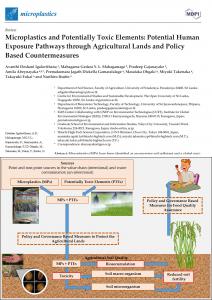Microplastics (MPs) have been identified as an emerging soil pollutant and a global environmental concern. Scientists have recently paid attention to the contamination of soil by MPs as their detrimental impacts on soil systems are largely unknown. MPs are considered to be vectors for other soil contaminants, such as potentially toxic elements (PTEs) and organic contaminants. PTEs are persistent contaminants and are often released into soils in large quantities. MPs adsorb PTEs, mainly via electrostatic attraction and surface complexation, and increase their mobility in soils. These complexes can be easily absorbed by plants; hence, the accumulation of PTEs in plants can be enhanced in both microplastic and PTE contaminated soils. Furthermore, there is a high risk of food chains contamination by PTEs due to crops grown in both microplastic and PTE-contaminated soils. Consequently, countermeasures including policy- and governance-based approaches that target circular economy as well as reduce, reuse, recycle (3R) applications are being discussed around the world to minimize the environmental contamination of MPs.
Microplastics and Potentially Toxic Elements: Potential Human Exposure Pathways through Agricultural Lands and Policy Based Countermeasures
- Authors
-
Avanthi Deshani Igalavithana, Mahagama Gedara Y. L. Mahagamage, Pradeep Gajanayake, Amila Abeynayaka, Premakumara Jagath Dickella Gamaralalage, Masataka Ohgaki, Miyuki Takenaka, Takayuki Fukai, Norihiro Itsubo
- Editors
-
Nicolas Kalogerakis
- Copyrights
-
This is an open access article distributed under the Creative Commons Attribution License which permits unrestricted use, distribution, and reproduction in any medium, provided the original work is properly cited
- Publication Date
-

